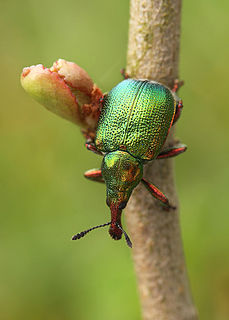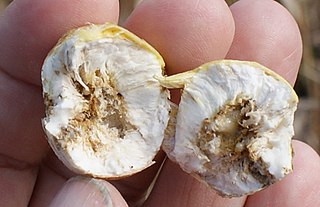
The northern flicker or common flicker is a medium-sized bird of the woodpecker family. It is native to most of North America, parts of Central America, Cuba, and the Cayman Islands, and is one of the few woodpecker species that migrate. Over 100 common names for the northern flicker are known, including yellowhammer, clape, gaffer woodpecker, harry-wicket, heigh-ho, wake-up, walk-up, wick-up, yarrup, and gawker bird. Many of these names derive from attempts to imitate some of its calls.

The forest bug or red-legged shieldbug is a species of shield bug in the family Pentatomidae, commonly found in most of Europe. It inhabits forests, woodlands, orchards, and gardens.

The plum curculio is a true weevil native to the regions east of the Rocky Mountains in the United States and Canada. It is notorious for destroying fruits if left uncontrolled.
The golden mouse is a species of New World mouse. It is usually 5–8 inches (12–25 cm) in body length, and has a soft pelage that ranges from golden-brownish to burnt orange in color. The genus name comes from the Greek words, "ochre", a yellow or brown earth pigment, and "mys," meaning mouse.

Hylobius abietis or the large pine weevil is a beetle belonging to family Curculionidae. This species is widely regarded as the most important pest of most commercially important coniferous trees in European plantations. Seedlings planted or arising from natural regeneration after clear felling operations are especially at risk. The adult weevils cause damage by eating the bark of seedlings around the 'collar' of the stem, thus 'ring-barking' the tree seedling which usually results in its demise.

Melanochromis auratus, the auratus cichlid, is a freshwater fish of the cichlid family. It is also known as golden mbuna and Malawi golden cichlid. It is endemic to the southern region of Lake Malawi, particularly from Jalo Reef southward along the entire western coast down to Crocodile Rocks.

The New Zealand giraffe weevil, Lasiorhynchus barbicornis, is a distinctive straight-snouted weevil in the subfamily Brentinae, endemic to New Zealand. L. barbicornis is New Zealand's longest beetle, and shows extreme sexual dimorphism: males measure up to 90 mm, and females 50 mm, although there is an extreme range of body sizes in both sexes. In males the elongated snout can be nearly as long as the body. Male giraffe weevils use this long rostrum to battle over females, although small males can avoid conflict and 'sneak' in to mate with females, sometimes under the noses of large males. The larval weevils tunnel into wood for at least two years before emerging, and live for only a few weeks as adults.
Phytotriades is a genus of tree frogs in the family Hylidae. As currently delimited, the genus is monotypic and contains Phytotriades auratus, commonly known as the golden tree frog, bromeliad-dwelling treefrog, El Tucuche golden tree frog, or Trinidad heart-tongued frog.

The gray snub-nosed monkey, also known as Brelich's snub-nosed monkey, Guizhou snub-nosed monkey, and Guizhou golden monkey, is a species of primate in the family Cercopithecidae. It is endemic to China, where it is known as the Guizhou golden hair monkey (黔金丝猴) or gray golden hair monkey (灰金丝猴). It is threatened by habitat loss. Of the three species of snub-nosed monkeys in China, the gray snub-nosed monkey is the most threatened, with a total population of less than 750 in around 20 groups surviving in the wild.

Abraxas sylvata, the clouded magpie, is a moth of the family Geometridae that was named by Giovanni Antonio Scopoli in 1763.

Enarmonia formosana, the cherrybark tortrix or cherry-bark moth, is a small but colorful moth species of the family Tortricidae. It is native to all of northern and western Europe, ranging south to the Maghreb. North of the Alps its range extends eastwards to Siberia and Kazakhstan. Possibly and most likely introduced populations are found in Asia Minor and North America, respectively.

A pheromone trap is a type of insect trap that uses pheromones to lure insects. Sex pheromones and aggregating pheromones are the most common types used. A pheromone-impregnated lure, as the red rubber septa in the picture, is encased in a conventional trap such as a bottle trap, Delta trap, water-pan trap, or funnel trap. Pheromone traps are used both to count insect populations by sampling, and to trap pests such as clothes moths to destroy them.

Phyllobius glaucus is a species of weevil found across Europe, especially in carrs. It is a pest of a variety of fruit trees, but has little economic effect. It was first described by Giovanni Antonio Scopoli in 1763.

Aleurocanthus woglumi is a species of whitefly in the family Aleyrodidae. It is a pest of citrus crops, and is commonly known as the citrus blackfly because of its slate-blue colour. It originated in Asia, but has spread to other parts of the world. The parasitic wasps, Encarsia perplexa and Amitus hesperidum can help control the pest.

Polydrusus formosus is a species of broad-nosed weevils belonging to the family Curculionidae, subfamily Entiminae.
The pecan weevil, Curculio caryae is an obligate feeder on the nuts of North American hickories and pecans, most widely recognized as an economically important pest of the pecan, Carya illinoinensis. It has also been observed to infest one Juglans species, the Persian walnut, Juglans regia.

Phyllobius pyri, the Common Leaf Weevil, is a species of broad-nosed weevil belonging to the family Curculionidae subfamily Entiminae.

Rhynchites is a genus of leaf and bud weevils in the family of beetles known as Attelabidae.




















